How much of what you do is actually your choice? What if you were secretly being controlled by a parasite that had infected your brain? What if that infection was spreading?
Guests:
- David Walton, author of The Genius Plague
- Tade Thompson, author or Rosewater
- Charissa de Bekker, researcher at the University of Central Florida
- Sandeep Ravindran, science journalist
Further Reading/watching:
- The Genius Plague KIRKUS Review
- Cover Launch for Rosewater
- The ants (Hymenoptera: Formicidae) and their parasites: effects of parasitic manipulations and host responses on ant behavioral ecology.
- Gene expression during zombie ant biting behavior reflects the complexity underlying fungal parasitic behavioral manipulation.
- Species-specific ant brain manipulation by a specialized fungal parasite.
- This tiny brain parasite seems to make rodents braver—and it likes humans, too
- Fatal attraction in rats infected with Toxoplasma gondii
- Can the common brain parasite, Toxoplasma gondii, influence human culture?
- Mechanisms of Host Behavioral Change in Toxoplasma gondii Rodent Association
- Engineering a parasite to tell you where it has been
- Protozoan Parasite Toxoplasma gondii Manipulates Mate Choice in Rats by Enhancing Attractiveness of Males
- Adaptive host manipulation by Toxoplasma gondii: fact or fiction?
- Morbid attraction to leopard urine in Toxoplasma-infected chimpanzees
- This parasite may turn you into a entrepreneur
- Toxoplasma gondii and Schizophrenia
Here’s the Planet Earth video of cordyceps:
Flash Forward is produced by me, Rose Eveleth. The intro music is by Asura and the outtro music is by Hussalonia. The voices from the future this week were provided by Charles Anderson, David Dunsmuir, Anthony Friscia, Andrea Klunder and Brent Rose. Check out Brent’s project Connected States, in which he drives around the US in a big van, at http://www.connectedstates.com/. You can listen to Andrea’s podcast The Creative Imposter wherever you get your podcasts. If you want to be a voice in a future scene for Flash Forward, that is one of the perks of a $10 Patreon pledge! Whenever I need voices I send out a little note to those patrons and people can sign up to do one!
The episode art is by Matt Lubchansky. Who is amazing! You should check out their art AND you should go look at the new magazine that they’re creating at the comics website The Nib. Go to membership.thenib.com to learn more about that.
If you want to suggest a future we should take on, send us a note on Twitter, Facebook or by email at info@flashforwardpod.com. We love hearing your ideas! And if you think you’ve spotted one of the little references I’ve hidden in the episode, email us there too. If you’re right, I’ll send you something cool.
And if you want to support the show, there are a few ways you can do that too! Head to www.flashforwardpod.com/support for more about how to give. But if that’s not in the cards for you, you can head to Apple Podcasts and leave us a nice review or just tell your friends about us. Those things really do help.
FULL TRANSCRIPT BELOW
▹▹ ▹▹ ▹▹ ▹▹ ▹▹ ▹▹ ▹▹ ▹▹ ▹▹ ▹▹ ▹▹ ▹▹ ▹▹ ▹▹ ▹▹ ▹▹ ▹▹ ▹▹ ▹▹ ▹▹ ▹▹ ▹▹ ▹▹
Hello and welcome to Flash Forward! I’m Rose and I’m your host. You might notice, if you are a regular listener, that my voice is a bit scratchy today — I may or may not have had a bit too much fun at karaoke recently. But we’re going to get through this! What is this, you might ask, if you happened to download this without any idea of what you were getting yourselves into!? Great question. Flash Forward is a show about the future. Every episode we take on a specific possible… or not so possible future scenario. We always start with a little field trip to the future, to check out what’s going on, and then we teleport back to today, to talk to experts about how that world we just heard might really go down. Got it? Great!
This episode we’re starting in the year 2028.
Woman’s voice: Hey robot, play me my news feed.
News Voice: Something new — and quite frightening — appears to be happening with the Nicolle-Manceaux virus, commonly referred to as NM. For decades, NM was a virus that appeared largely in monkeys, and only occasionally in humans, with mild symptoms. There have been a few small NM outbreaks over the years, but very few cases are severe enough to even report symptoms. Things began to change last year, when cases of NM began appearing in Southeast Asia and Africa, accompanied by a host of new, strange symptoms. Those infected with NM reported strong cravings for dairy products like milk and cheese, as well as difficulty sleeping, restlessness, and a strong desire to be around crowds. Doctors only connected these cases with the NM virus after a young child was trampled in an intersection in Calcutta.
Now, the CDC has expanded the list of countries that Americans should avoid because of NM. Health officials say they still don’t know why the NM virus is causing these changes, how long they last, or whether they are in and of themselves dangerous. So far, there is no treatment for NM.
Woman’s voice: Next.
Talk Radio Voice: Okay, here’s the thing. We’re meant to believe, and again, I’m just repeating what I’m reading right now, but this is what they’re saying, we’re supposed to believe that this “infection” is brand new. Came out of nowhere! These scientists want us to think that there was simply no warning. No signs. Not a single case that made anybody say, “hey, wait a minute now, this is kinda weird.” And now, now we have what? Thousands of cases? Again, there’s something about all of this that the longer it goes on, the more incredulous I am at it. When you realize the depth, the planning, the number of people involved here. What’s the budget for the National Science Foundation again? Eight BILLION dollars? And I’m supposed to believe that this was a complete surprise? Now, I can imagine there are people in the audience saying, “No, Rush. You’re overthinking this. They’re just idiots, they’re just bad at their jobs. You know scientists are full of it, you know that, they just take the money and squirrel it away and it’s a waste.” Yes, yes, certainly true in most cases. But this, listen, I just don’t buy it. I don’t buy it! There’s something more going on here, something they don’t want you to know. We’re talking about literal mind control here, and you expect me to believe that not a single person in the government knew about it? Please? The cats gotten out of the bag and they’re doing damage control.
Woman’s voice: Next.
News Voice: Blood donation in the United States has screeched to a halt, as the NM outbreak continues to worsen. The FDA originally mandated that all donated blood be tested for NM, but since the mandate several cases have been reported of the virus being spread via blood donation. In the wake of the transmission, donation has been paused completely, and experts worry that blood banks might soon dry up completely.
Woman’s voice: Next.
YouTube Host: Welcome to another session with Dave and myself. Today, we’re going to show you how to protect yourself. What you’re going to need is some masking tape. You can buy it at any Home Depot, it’s cheap stuff. It doesn’t have to be expensive. Dollar store… wherever you can get it, whatever you can afford. Remember, this is all based on your economics. Now, what you’re going to do, is you’re going to get magnets. I got these at Michael’s, got about 52 or 55 of them for fifteen bucks.
Woman’s voice: Next.
News Voice: The Center for Disease Control and Prevention announced this morning that the NM vaccine was still months away. The announcement comes as panic around NM continues to grow, as the virus spreads. Without national guidance on what to do, local officials have taken precautions into their own hands. In New York City the outbreak has caused complete havoc on the streets and in the subways. People infected with NM seek out crowds, which has caused several fatalities in the subway system, as hoards of infected people crowd the subway platforms eventually pushing people onto the tracks. New York City mayor, Zebediah Killgrave, issued a state of emergency last week, and mandated that anybody infected with NM must remain indoors.
Woman’s voice: Next.
YouTube Host: Hey guys, another video here to help you protect yourself against NM. Doctors say you basically can’t, but that’s a lie, of course. They just want you to think that. You can actually protect yourself. So today, I’m going to show you how to make this anti-NM suit. You’re going to need some clothes you don’t care about — I got a pair of sweats at Walmart. You also need… a bucket. Like a paint bucket. And then you need bleach, apple cider vinegar, propane, and RAID, like the stuff you use to kill cockroaches.
Woman’s voice: Next.
Rose: Okay so… in this future, a parasite has infected humans, making them behave… strangely. Wanting to eat new foods. Seeking out other people. Generally wreaking havoc and causing all sorts of weird things to happen. So basically what we’re talking about here is mind control by parasite.
And this is an idea that’s at the heart of two recent science fiction novels. The Genius Plague, by David Walton
David Walton: The Genius Plague is about a fungal disease that spreads and takes root in humans.
My name is David Walton. I am a science fiction author and that’s both who I am and what I do. Does that cover it?
Rose: And Rosewater, by Tade Thompson
Tade Thompson: Rosewater is about a very slow invasion and its effect on one particular man.
I’m Tade Thompson. I am the author of the book Rosewater and other books. I work as a psychiatrist in a general hospital in my day job. So writing is my secret identity.
Rose: In The Genius Plague, the fungus is Earthly.
David: The basic idea is that this disease, if you survive it, which most do, will give you a certain advantage. You’ll have this fungus living symbiotically in your brain, and it allows you to think more clearly, make better connections, learn more easily, learn languages especially, communicate more easily with other people who have this same symbiotic fungus.
Rose: In Rosewater, the infection is alien.
Tade: It’s an alien invasion story, it’s a sort of redemption story, it’s a story about the character himself, Kyra. It’s a kind of allegory about how Africa was colonized, as well. So it’s fun for all the family, really.
Rose: Now, these two books have a lot of differences, and I won’t spoil too much of the plot of either one for you, but they also have some really interesting similarities. Because they’re both rooted in this idea of a parasitic infection that behaves like a fungus. One of the key things that happens in The Genius Plague, is that those infected by the fungus become connected to one another. And that happens in Rosewater too — people who are infected by this alien fungus-like thing can access something Tade calls the xenosphere. And this idea of connectivity, and connectedness, comes from the very real biology of fungi.
David: Fungi can can do that. They can spread over a long distance and then communicate. Kind of like an neural network, you have this vast network. It has no central point. So it’s not like there’s some central brain that is sending out these tendrils, and bringing the information back to the central point. Every bit of it is the same. And yet, it manages to have some very sophisticated functions. Where it’s communicating, and in some ways; you wouldn’t say thinking necessarily, depending on what you mean by that. But it’s making decisions, determining that this bit of moisture is better over there, and these nutrients are better over this way. But you could destroy any part of it, and the whole is still there.
Tade: Their main effect is the storage and transfer of information, which is not so complicated for a fungus. The hyphae, the fruiting bodies, are the long strands of a fungus. They actually have enough in common with a neuron that you could use them for neurotransmission. That’s the part of it that I really use from fungi. The way they’re designed, you could conceivably transmit a nervous impulse along their hyphae.
Rose: In both books, the parasite that has infected humans is mostly interested in surviving. It needs humans to do that, but it doesn’t really care about humans, or our well being, exactly. And one of the first things that happens in both stories, when these infections being to spread, is that governments get involved.
Tade: There’s no way a government organization isn’t going to get involved.It’s a global thing. It needs command and control, it needs resources, it needs to have some sort of overreaching powers to make some sort of decision. You need organization to be that otherwise the human race is doomed. So yeah, that had to happen.
David: So the in the actual plot, there is a man who is working for the NSA who is seeing, kind of subtly, the changes that are happening in world governments and around the world as this thing spreads, and starts really shifting loyalties, and changing things, and having to grapple both in that global scale and in his own personal scale with his brother who is a mycologist and his father who has Alzheimers. Which could possibly be reversed or even cured with this. Whether this is, in fact, something that is good for humanity or not.
Rose: And of course this makes sense — if you have a parasite that is changing the behavior of people all over the world, that’s… a small issue! We talked a bit about what might happen during an outbreak a few episodes ago, but this is a slightly different thing, right?. It’s not killing people. It’s just… changing them. And that’s kind of scary too, right? How can you know who is acting under their own power, and who is being secretly being controlled by this infection. In both books, different countries react differently to the infection.
Tade: One of the things that happens when you get a visitor or a stranger that you don’t know, is that you project intent onto a stranger. And the projection that you do is actually based on what you would do if you were a stranger in a place. So, the United Kingdom, for example, has a history of going to other people’s countries and taking over their resources, and taking over their governments. There’s a long history of that. So it is natural, for example, for the United Kingdom to think, if aliens are coming they’re going to be hostile. And we’re going to have to fight them.
Rose: In Rosewater, America just goes completely dark.
Tade: The United States reacts in the way they do because… that was basically an extrapolation of what’s already happening. More and more, you’re kind of withdrawing from the world, and pulling into your borders, and saying, “OK look, we’re just going to be Americans, the rest of you can do whatever the hell you like.”
Rose: Rosewater is set primarily in Nigeria, and in Nigeria they just learn to live with these aliens.
Tade: Africa, on the other hand, again, has already experience colonialism; we’ve already been invaded by pretty much every western nation there is. And we kind of have an idea; we have the experience of dealing with aliens because the British were aliens to us, at least to Nigerians, anyway. The Germans were to others, the French to others, and so on. And the idea was that you had people coming; one who did not look like us, and two who were basically technologically advanced. But didn’t speak our language. So they were aliens by any definition. By any way you look at it, they were aliens to us. So we had to negotiate how to live with them, basically. So that’s how I made my choices.
Rose: In The Genius Plague, there are also people who accept this fungus into their lives. In fact the main tension in the book is between two brothers — one of whom is infected and one of whom who is not. The one who’s infected, believes that the enhanced cognitive abilities he has thanks to the fungus, are totally worth it. And this character, Paul, goes on these long rants about how this basically is the next step in human evolution.
David: Paul is very well reasoned. He’s not a mindless automaton, that is just repeating some phrase. You know, he’s a very intelligent – even more intelligent now in fact – person who is able to argue quite clearly and oftentimes convincingly about the value of this, and how it shouldn’t be feared, and how it’s good for humanity. And I think sometimes you read his arguments and you’re convinced by them.
Rose: And some of the arguments that Paul makes in the book are… very familiar to me. If you have ever read about, or think about, or talk to transhumanists, people who are really interested in updating, and upgrading, and altering their bodies, you hear these exact kinds of arguments all the time. And that’s what David was going for.
David: You know, I want people to be asking the questions and thinking about those kind of deeper philosophical ideas of is there a real me? And what does it mean when I’m changing all the time? I’m a different person than I was a year ago, or 10 years ago, or five minutes ago to some extent. And I’m influenced by the people around me, as well as by everything that I put into my body and experience. So Paul’s arguments that this is the real me can be can be fairly convincing.
RoseL And this question of how much a fungus or parasite might change the “real you” in big air quotes, is another key link between The Genius Plague and Rosewater. Both books really poke at this idea of what it means to have a true personality, what it means to be altered or not in control of your real self.
David: You know, we think of ourselves as entirely autonomous, but what are the things that can change who we are? From little things like drinking a Coke, or some alcohol. To more substantial drugs, or in this case, say a fungus living in your brain.
Tade: What I’m kind of leading up to is the idea or the illusion of free will. As you are growing up, you’re also being programmed by the society into which you’ve been born, into which you live. Okay. So the society tells you, “this is how to behave.” If you want something, you say please. The other person says thank you. And those are the social lubricants, this is how you ask someone you like to a date. This is the way you work. You go to work on time, you come back. You don’t take other people’s property. This is what we do to people who break the social contract. And so on, and so on, and so on. Everyday, people wake up, brush their teeth, put on their clothes, shower, do whatever. Go to work, come back, then they put on television, as if they made a choice to do so. But in fact, they have been programmed to do most of what they did that day. They’ve been programmed in how to respond to aggression, pretty much everything they’re doing has been programmed into them.
Rose: So how different is that, really, from, say, a mind controlling parasite?
Okay it’s very different but you get what I’m saying here, right!? This idea that we have full control of our decisions all the time is already a bit of an illusion. Why not hand our decision making over to a fungus that’s controlling our brains? No? Okay… fine.
So both David and Tade have thought a lot about this parasite stuff in their fictional worlds. And in both books there is a struggle between the parasite and the humans. But if this really happened in the real world, Tade says that he is confident in our ability to kill whatever it is.
Tade: Humans can pretty much kill anything. We will figure it out. People will die. But we will definitely figure it out. Somebody will make the hard choices, but we will we will figure it out. We can kill anything.
Rose: But how possible is this scenario? How likely is it that humans could be infected by a parasite that controls our behavior? In reality, it probably wouldn’t be a fungus. Here’s where it’s helpful that Tade is also a doctor.
Tade: I should probably point out at this point that if you get a fungal infection that affects your brain or spinal cord, it’s probably going to be deadly. I mean, if you get candida of the nervous system, or if you get something like aspergillosis, things like this, they’re going to give you meningitis and you’re going to die if you don’t get treated.
Rose: But it could be something else, in theory. And in fact there are examples of this really happening in nature. And when we come back, we’re going to talk about some real life mind controlling parasites in two different species: ants and … humans!
[ADS]
Okay so we’re leaving the realm of science fiction now, and moving into the realm of things that seem like science fiction, but in fact are totally real.
Probably the most famous example of a mind controlling fungus is something called Ophiocordyceps unilateralis aka cordyceps.
Charissa de Bekker: And generally these are the fungi that we see infecting ants. And it’s not that they just infect them and kill them, but they actually take over the behaviour of these ants.
My name is Charissa de Bekker. I’m an assistant professor of biology at the University of Central Florida, and my lab studies zombie ants
Rose: Yes, zombie ants!!! You might have heard of this before, but cordyceps infects ants all over the world. Charissa studies cordyceps that infect a group of ants commonly known as carpenter ants.
Charissa: So, carpenter ants are super common, you see them all all over the globe. They’re they’re rather big most of the time. And sometimes people refer to them as wood ants. Because you see them, for instance, in around your house at the East Coast of the U.S. Some of the species are actually considered a pest because they get into buildings, and they do some damage there. But mostly these carpenter ants are in the woods; you can find them either by nest in the forest floor or in dead tree stumps.
Rose: Side note, when I was a kid we had a carpenter ant infestation in our house and it was NOT GOOD.
Cordyceps is probably the most famous example of a fungus that infects ants. In fact, Charissa got interested in studying these zombie ants after seeing a segment about them on the BBC
Charissa: Just watching BBC Planet Earth, the easy way to get some knowledge about the natural world around us. I was just mesmerized by these fungi.
Rose: So with the help of David Attenborough, let’s talk about what happens when these ants get infected by the cordyceps.
First, a spore from the cordyceps infects the ant. And scientists actually still don’t know exactly how that infection happens.
Charissa: So it could be: one that the spore just lands on the ant, kind of attaches to it and then is able to to grow and push itself through the cuticle of the ant and go inside inside the body. Or the spores fall on the forest floor, and then from those spores other structures will form. And then the ants kind of walk over and pick up those secondary structures. So we think it’s either of those two situations, but we don’t know exactly what’s going on here
Rose: Either way, once the spore gets into the ant, and starts to grow, it starts to change the ants’ behavior. Normally ants are very, very social.
Charissa: These ants seem to become a little bit asocial. They don’t react to their sister so well anymore. And at one point they decide to leave the nest, climb up the vegetation
David Attenborough: It’s infected brain directs this ant upwards,
Then, utterly disorientated it grips a stem with its mandibles
Charissa: That’s where they will latch on, so they will bite onto either a leaf or a twig. And this is eventually where the fungus kills them.
Attenborough: Like something out of science fiction the fruiting body of the cordyceps erupts from the ant’s head.
Rose: So you really have to see this video because what’s happening now is that this very long, thin stalk is just… growing out of the ant’s head. And it just keeps growing.
Attenborough: It can take three weeks to grow. And when finished, the deadly spores will burst from it’s tip. Then any ant in the vicinity will be in serious risk of death.
[music fade out]
Rose: I’ll post a link to that BBC clip in the show notes, because if you’ve never seen it, you really have to check it out. It’s incredible.
And while the BBC clip focuses on ants in the jungles of the Amazon, this happens in ants all over the world.
Charissa: One of the other reasons why my lab is in Florida is because here in central Florida this infection is actually quite common. When we go out for a hike here, and if you know what to look for, you can actually quite easily find infected ants latching onto to palm leaves, for instance. Yes. It’s very very common here.
Rose: I knew about cordyceps before this, but I had no idea that you could actually go out and find them in Florida. If you live in Florida and you go on a hike some time soon, please be on the lookout for these and take pictures. I really want to see one.
So, we know that this fungus does this to ants. Charissa sees it in her lab, they see it in the wild, but there are still a ton of unanswered questions about how exactly cordyceps does this. Like, is it turning on certain genes? Is it whispering in the ant’s ear? How does it actually make the ant do stuff?
Charissa: So what we think is that the fungi are secreting certain bioactive compounds. such as alkaloids.
Rose: Bioactive compounds are basically compounds that do stuff to biology. And alkaloids are a big group of molecules with a lot of different properties, but they include things that we already know alters behavior like caffeine and LSD.
Charissa: So a mind altering compound that is affecting the brain in a certain way to change the behavioral output.
Rose: But it’s not just alkaloids, Charissa thinks that there are a ton of compounds involved here.
Charissa: A whole bunch of compounds we think the fungus is secreting very precisely to manipulate the behaviors that kind of draw the strings of it’s ant puppet, as people like to say.
Rose: To figure out what might be going on, she basically creates zombie ants in her lab.
Rose [on the phone]: So you have a lab full of zombie ants.
Charissa: Not a whole lab full. Most most of our ants are just happy, healthy carpenter ants that are kind of freeloading right now, because they get a lot of sugar and protein from us that they don’t have to really go and explore the forest for. So most of them are just Happy-Go-Lucky carpenter ants. Yes we do have some zombie ants in there.
Rose: Okay so not a whole army of zombies, but some zombies. And what she does is basically try to press pause on the infection at various times, and then measure what’s going on with both the fungus and the ant at different stages of the infection.
Charissa: For instance, if you then look at the ant at the point of where it’s actually going to bite the leaf or or twig or such that we give them. We quickly sample the ant, get RNA out of the ant and study the gene expression in both the ant and the fungus. So we get an idea of what genes are actually activated at the different time points.
Rose: With each little piece of this they can start to construct a timeline of what’s happening at each moment of this infection. It’s slow going work, but they’re starting to build a picture of what might be happening inside these ants.
Humans are never going to be infected by cordyceps. In fact, cordyceps and their ant hosts have been evolving alongside one another for a very long time.
Charissa: As far as we know, as far as the species have been described, the fungus seems to be co-evolving very closely with its host. In such a way to each ant host that gets infected with cordyceps has its own specialized species Ophiocordyceps infecting it.
Rose: Which means that cordyceps is not going to jump over to humans. But there is a parasite that does infect humans, and you might have heard about it changing our behavior.
Sandeep Ravindran. Overall it’s about 30 percent, or a third of the world basically, is infected with toxo. At some point, there were some studies that showed that I think 85 percent of France was infected with toxo.
It wouldn’t be a stretch to call it, by far, the most successful parasite that we know of.
Rose: This is Sandeep Ravindran
Sandeep: I’m a freelance science writer. And before I became a science writer, I actually used to study toxoplasma or toxo. And that’s what I did my Ph.D. on.
Rose: Toxoplasma, or toxo for short, is this weird little parasite that lives inside animal cells. And it’s found in tons of different animals.
Sandeep: It’s in cats, and otters, and kangaroos, and dolphins, and birds, all kinds of different birds.
Rose: And its found in humans. Most of the time, a toxo infection in a human is no big deal. If you happen to get infected with toxo while you’re pregnant, it does increase your risk of miscarriage or birth defects. For everybody else,
Sandeep: it just feels like a mild flu. So it’s really some headache, maybe fever, but nothing too serious and it goes away within a couple of weeks.
Rose: But they key thing here is that once you have toxo, you have it forever. The parasite lives inside your cells and there’s pretty much no way to get it out. Which can wind up causing problems for some people down the road.
Sandeep: If you, at some point later, become immunocompromised it can sort of burst out of the cyst where it’s hiding, and cause a severe infection again. So it’s usually not a problem for you, unless you’re immunocompromised.
Rose: Now, you might have heard of toxo before. Because even though it’s not a super dangerous parasite for humans in most cases, it does have some very weird effects on rodents.
Sandeep: Rats and mice have this really strong innate fear of cats and cat urine, and once they’re infected with toxo basically this fear seems to go away. So now, they’re more willing to hang out in places where there’s cat urine, versus the ones that aren’t infected with toxo. They just want to get the hell away from anything remotely that smells like cat urine.
Rose: Okay, so normally, if a rodent like a rat or a mouse, smells cat urine, they run away. Which makes sense, right? Cat urine means cat which means danger. But in 2000, a parasitologist named Joanne Webster found that rats that were infected with toxoplasma were way less afraid of cat urine than those who were not infected with toxoplasma.
And when Webster published her work in 2000 everybody was super skeptical. But this effect is real, and has been replicated over and over again. But, let’s not overstate this. The toxo mice are simply a little bit less afraid of cat urine than the non-toxo mice.
Sandeep: I don’t know if… the fatal feline attraction might be a bit of a stretch. If you actually put a cat there, they will still run away. So it’s not like they’re just jumping into the cat’s mouth, because now they’re attracted to them.
Rose: So, the other thing you should know about toxo is that in order to reproduce it has to find its way into cats.
Sandeep: It gets into cats, it reproduces sexually, and then comes out in cat poop.
Rose: So toxo has to get into cats, and toxo infection makes mice and rats less afraid of cats. Which is a very interesting connection, right? This suggests that the toxo is actually manipulating the brains of these rodents so that they are more likely to find their way into a cat’s belly, so that that toxo can then infect the cat and reproduce.
And this has led to another theory that involves humans. Which is the so called “crazy cat lady hypothesis.” We know that toxo can manipulate rodent behavior to be less afraid of cats. We also know that toxo wants to be inside of cats to reproduce. So this theory goes that perhaps, toxo is also manipulating humans to like cats more, so that the toxo inside humans can get into cats and can reproduce and spread. So people who love cats, people with like fifteen cats, might actually love them because a parasite is manipulating their brain into loving them, so that it can finish its life cycle.
I actually read about this years ago, and until doing research for this episode, I thought it was true. In fact… it is almost certainly not true.
Sandeep: As far as we know, no. There’s no evidence.. or there’s no evidence that is convincing that being infected with Toxoplasma either makes you like cats more, or makes you want to be around cats more. or any such thing, or makes you crazy cat lady.
Rose: In fact, researchers are not convinced that the toxo is actually intentionally making rodents less afraid of cats specifically in order to finish their life cycle. It might instead be a coincidental side effect of another thing that toxo does, which is making male rodents more attractive to female rodents. We won’t get into the nitty gritty on the competing theories about how toxo works and what is actually happening right now — but Patrons will get an explainer on this in their newsletter this week! So if you want that, go to patreon.com/flashforwardpod and sign up for the newsletter tier.
So, there’s no evidence at all that toxo manipulates humans to like cats more. But that’s actually not the only claim people have made about what toxo might be doing to humans.
Sandeep: There’s been some studies looking at saying that if you’re infected with toxo, you’re more likely to get into traffic accidents. Or have episodes of explosive rage. There’s even been some even more speculative studies that said that pretty much all global cultural differences might be at least likely attribute it to toxo.
Rose: Studies have tried to make connections between toxo infections and suicide, schizophrenia, depression, and even things like business decisions. A recent study tried to make the claim that students infected with toxo were more likely to major in business than students without. Here’s a headline for that study: “Want to Be an Entrepreneur? This Cat Parasite Might Help You”
This is almost certainly not true. Most of these studies, in fact, should be taken with a huge grain of salt.
Sandeep: I’d say the vast majority of these studies are one off that haven’t really been replicated, or are not the most convincing.
Rose: There is one small exception to this.
Sandeep: I think the most studied is probably the association between toxo infection and schizophrenia. And that one, there’s been a ton of studies about this, and I think the consensus is that there’s probably a small but real association between the two.
Rose: Now, not everybody agrees that this link is real. Some studies find a connection. Some studies don’t. If there is any link between toxo and schizophrenia it is probably very small. And there is evidence to suggest that it doesn’t exist at all.
Sandeep: I mean, you have some countries where you only have a few percent of the population that’s infected with toxo, versus you have others where there’s 95 percent of people infected with toxo. But schizophrenia rates are pretty stable at around 0.5% to 1% worldwide.
Rose: The thing with toxo and mental illness is that it’s really hard to study.
Sandeep: The only way we really do these studies is by looking for the presence of antibodies to toxo. So basically, at some point you were infected and your body produced an immune reaction. And all we’re detecting is the after effects of that immune reaction. So this doesn’t tell us when the infection occurred, it doesn’t tell us… we know there are different strains of toxo, that may have different effects, but this doesn’t tell us what strain of toxo.
Rose: But even if there is a relationship between these two things, it’s really hard to tease out which direction the link goes. Humans get infected with toxo in a few main ways. The most common is handling or eating undercooked meat. So the toxo comes out of the cat’s butt in the form of poop, it gets spread into the soil, and gets eaten by grazing cattle or pigs, and winds up in their meat. And if you don’t cook your meat properly, you can get toxo from those animals. Another, less common way people get toxo is by handling cat litter, since it lives in cat poop. Or, you can get it just by handling dirt that has toxo living in it. So, when it comes to schizophrenia, it’s actually unclear and very hard to prove whether it’s that toxo is pushing people towards schizophrenia, or whether it’s that people with schizophrenia are more likely to handle cat litter or dirt, or consume undercooked meats, especially in countries with terrible mental health services where folks with mental health issues are given little to no support.
Sandeep: One of the ideal studies would be if you followed people from a young age, before they showed signs of mental illness. And you know we’re able to sort of check whether you were able to determine when they were infected with toxo; did it happen before they had the mental illness or did it happen after.
Rose: And in fact, even in mice and rats, where the cat urine effect is very well established, scientists can’t actually say much about how toxo impacts the interaction of rodents and cats outside the lab. In fact, scientists don’t even know if toxo infected rats and mice in the wild are more likely to actually be eaten by cats.
Sandeep: So, even though it’s compelling for us to think of toxo as sort of being this devious manipulator of behavior, even with the well-established effect of the toxo in rats, we don’t know that toxo is actually getting any benefit from that.
Rose: So the next time you see headlines about toxo being linked to personality, or mental health, or driving behaviors, or whatever it is, put on your skeptical hat.
And here’s the thing. It’s really tempting to talk about toxo as this parasite infecting people’s brains and making people do things. Whether that’s love cats, or run traffic lights, or become entrepreneurs, or have schizophrenia. This gets at this same question that Tade and David were asking earlier: how many of your choices are really yours, and how many of them are being subtly impacted by some foreign entity. But when it comes to toxo, there’s really no evidence that it’s controlling our brains. Instead, we are all still responsible for ourselves and our decisions, which is a terrifying and powerful thing. Way more powerful than any brain parasite.
[music up]
Flash Forward is produced by me, Rose Eveleth. The intro music is by Asura and the outro music is by Hussalonia. The voices from the future this week were provided by Charles Anderson, David Dunsmuir, Anthony Friscia, Andrea Klunder and Brent Rose. You can check out Brent’s project, Connected States, in which he drives around the US in a big van, at http://www.connectedstates.com/. You can listen to Andrea’s podcast The Creative Imposter wherever you get your podcasts. If you want to be a voice in a future scene for Flash Forward, that is one of the perks of a $10 Patreon pledge! Whenever I need voices I send out a little note to those patrons and people can sign up to do one!
The episode art is by Matt Lubchansky. Who is amazing, by the way! You should check out their art AND you should go look at the new magazine that they’re creating at the comics website The Nib. Go to membership.thenib.com to learn more about that.
If you want to suggest a future we should take on, send us a note on Twitter, Facebook or by email at info@flashforwardpod.com. We love hearing your ideas! I try to respond to every email that I get. And if you think you’ve spotted one of the little references I’ve hidden in the episode, email us there too. If you’re right, I’ll send you something cool.
And if you want to support the show, there are a few ways you can do that too! Head to www.flashforwardpod.com/support for more about how to give. But if that’s not in the cards for you, you can head to Apple Podcasts and leave us a nice review or just tell your friends about us. Those things really do help.

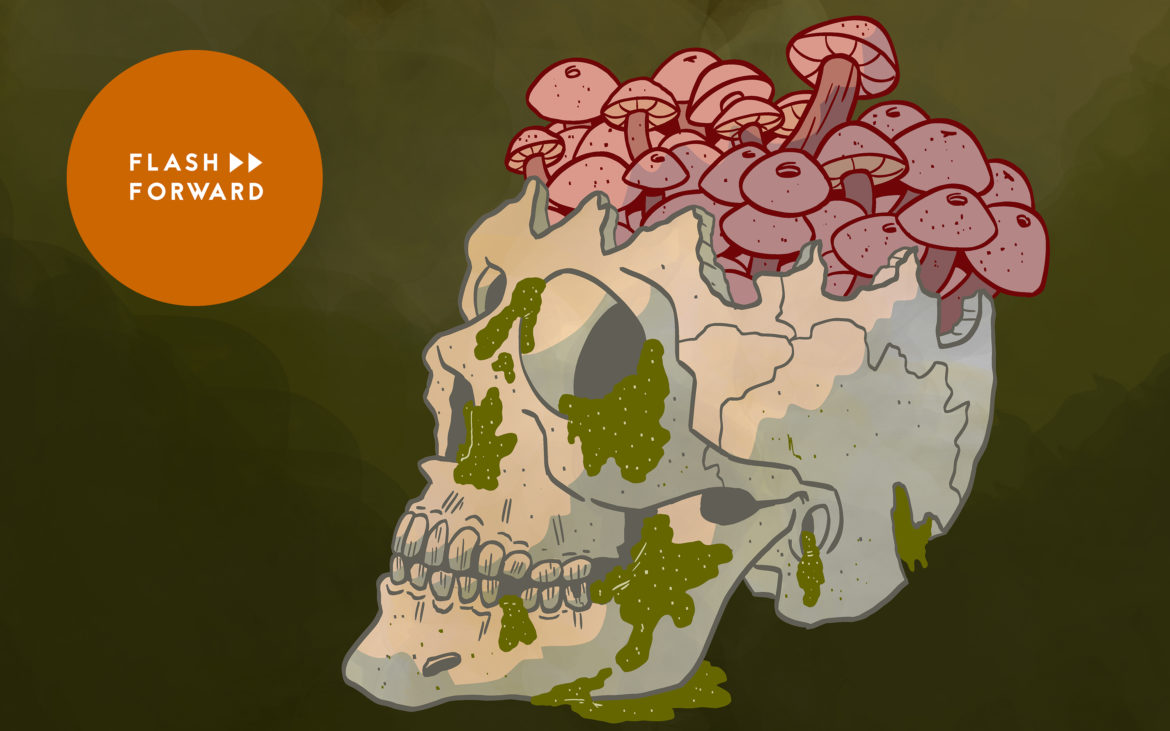
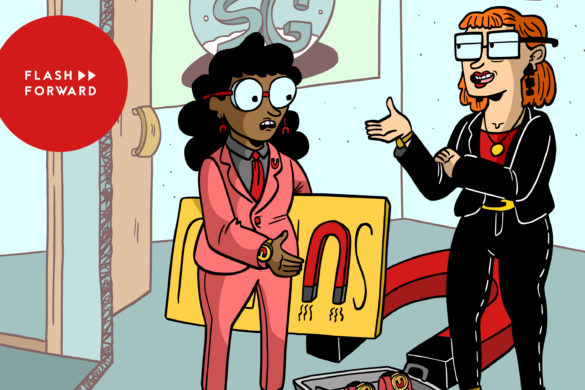
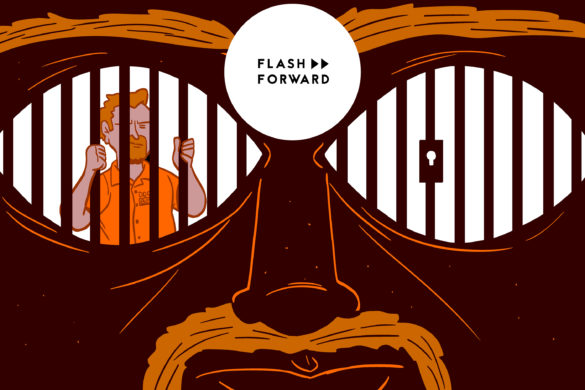


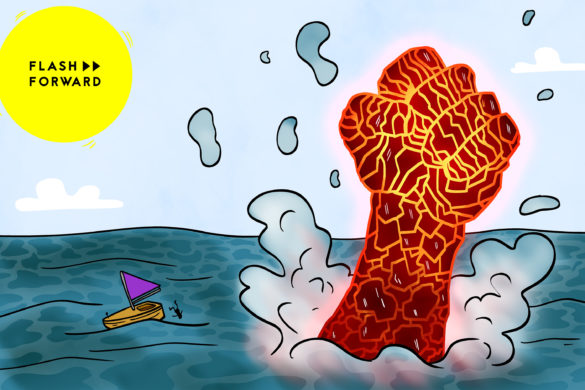
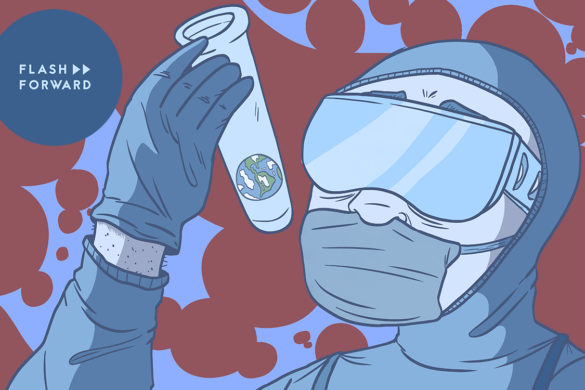
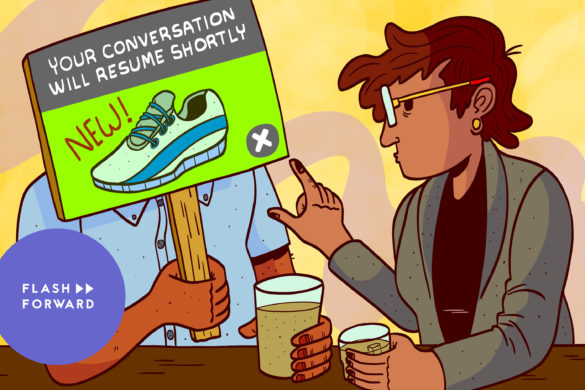


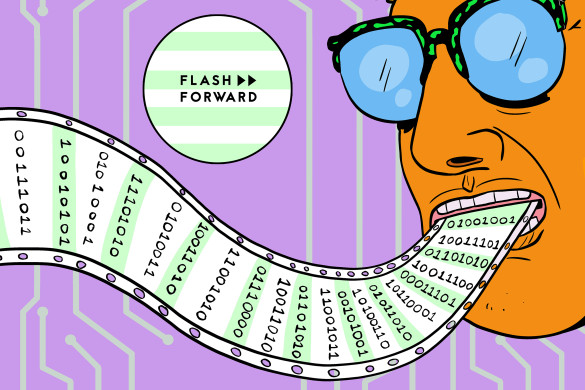
1 comment
Your story at the beginning – although ultimately not dealing with a fungus – reminded me of David Brin’s “The Giving Plauge”. It’s been a favorite short story since I first read it. See the link below if you want to give it a read.
http://www.davidbrin.com/fiction/givingplague.html